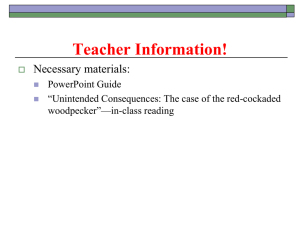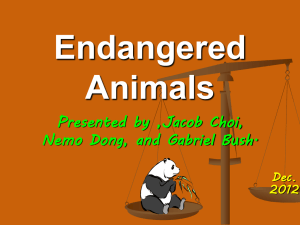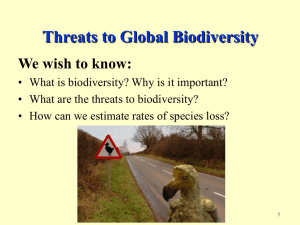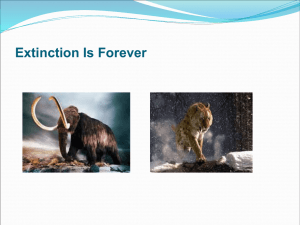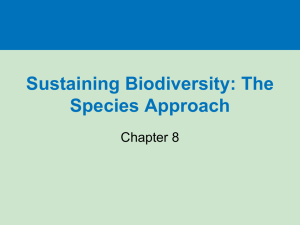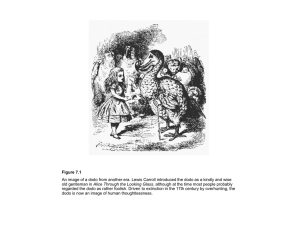Chapter 9 PowerPoint - the Kennedy APES website
advertisement
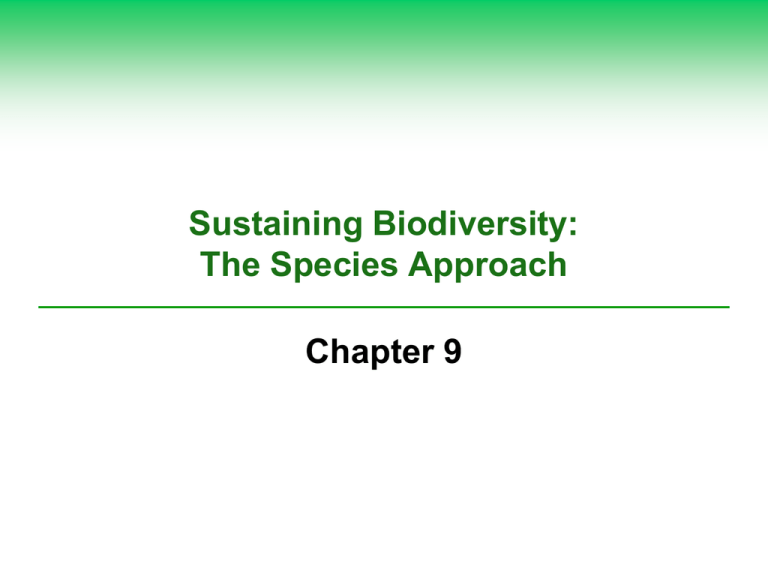
Sustaining Biodiversity: The Species Approach Chapter 9 Core Case Study: The Passenger Pigeon: Gone Forever Once the most numerous bird on earth. In 1858, Passenger Pigeon hunting became a big business. By 1900 they became extinct from over-harvest and habitat loss. 9-1 What Role Do Humans Play in the Premature Extinction of Species? Concept 9-1A We are degrading and destroying biodiversity in many parts of the world, and these threats are increasing. Concept 9-1B Species are becoming extinct 100 to 1,000 times faster than they were before modern humans arrived on the earth (the background rate), and by the end of this century, the extinction rate is expected to be 10,000 times the background rate. Extinctions Are Natural But Sometimes They Increase Sharply Background extinction and Mass extinction • Discussed in Chapter 4 Extinction rate – the percent of species that go extinct in a given time period. • Background extinction • 1/1,000,000 per year = 0.0001% • Mass extinction • 50 – 95% of all living things on the planet Extinctions Are Natural But Sometimes They Increase Sharply Species can become extinct in three ways: • Local Extinction: • A species is no longer found in an area it once inhabited but is still found elsewhere in the world. • Typically the result of habitat destruction and affects more than one species. • Ecological Extinction: • Occurs when so few members of a species are left they no longer play its ecological role. • Biological Extinction (Global Extinction): • Species is no longer found on the earth. • Biological extinction is FOREVER. Some Human Activities Cause Premature Extinctions; the Pace Is Speeding Up Estimates of current annual extinction rate: • 0.01-1.0% • 100 to 1,000 times greater than the background extinction rate of 0.0001% Experts predict extinction rates will increase over the next 50-100 years. Reason = US!! Animal Species Prematurely Extinct Due to Human Activities Many animals have become prematurely extinct because of human activities. • Development, habitat destructions, hunting, etc. Animal Species Prematurely Extinct Due to Human Activities “The first animal species to go are the big, the slow, the tasty, and those with valuable parts…” – Edward O. Wilson (biodiversity expert) Endangered Natural Capital: Species Threatened with Premature Extinction Threatened (vulnerable) species: • Still abundant in its natural range but is likely to become endangered in the near future. Endangered species: • So few individual survivors that it could soon become extinct. Endangered Natural Capital: Species Threatened with Premature Extinction Extinct Ex.: Dodo, Passenger Pigeon Extinct in the wild Ex.: Alagoas Curassow • Captive individuals survive, but there is no free-living, natural population Critically endangered Ex.: Ivory-billed Woodpecker, Javan Rhino • Faces an extremely high risk of extinction in the immediate future Endangered Ex.: Cheetah, Blue Whale, Snow Leopard Vulnerable Ex.: Lion, Wolverine Conservation Dependent Ex.: Leopard Shark, Bristlecone Fir • Would be threatened without active conservation programs. Near Threatened Ex.: California Red-legged Frog, Silvery Woolly Monkey • Likely to qualify as threatened soon. Least Concern Ex.:Brown Rat, Rock Pigeon, Common Juniper • No immediate threat to the survival of the species. Endangered Natural Capital: Species Threatened with Premature Extinction Endangered Natural Capital: Species Threatened with Premature Extinction Characteristics of Species That Are Prone to Ecological and Biological Extinction Some species have characteristics that make them more vulnerable to ecological and biological extinction. These characteristics make survival harder when environmental conditions change or when humans interfere. Percentage of Various Species Threatened with Premature Extinction Science Focus: Estimating Extinction Rates Is Not Easy Three problems with estimating extinction rate: • Hard to document due to length of time • Only 1.8 million species identified • Little known about nature and ecological roles of species identified 9-2 Why Should We Care about Preventing Premature Species Extinction? Concept 9-2 We should prevent the premature extinction of wild species because of the economic and ecological services they provide and because they have a right to exist regardless of their usefulness to us. Species Are a Vital Part of the Earth’s Natural Capital Instrumental value – Usefulness in terms of economic and ecological services • Use value – economic goods or services • Ecotourism: wildlife tourism • Genetic information • Nonuse value • Existence value – happy knowing they are around • Aesthetic value – pleasing to the eye • Bequest value – available for future generations Ecological value – vital component of the ecosystem 9-3 How do Humans Accelerate Species Extinction? Concept 9-3 The greatest threats to any species are (in order) loss or degradation of its habitat, harmful invasive species, human population growth, pollution, climate change, and overexploitation. Loss of Habitat Is the Single Greatest Threat to Species: Remember H.I.P.P.C.O. H.I.P.P.C.O. – the most important causes of premature extinction: • Habitat destruction, degradation, and fragmentation • Invasive (nonnative) species • Population and resource use growth • Pollution • Climate change • Overexploitation H.I.P.P.C.O. – HABITAT LOSS, DEGRADATION, AND FRAGMENTATION Habitat loss is the GREATEST threat to biodiversity on this planet. • • • • Deforestation Degradation of coral reefs Draining wetlands Plowing grasslands Habitat fragmentation – when a large continuous habitat is divided into smaller, scattered patches. • By roads, agriculture, urban developed, etc. H.I.P.P.C.O. – HABITAT LOSS, DEGRADATION, AND FRAGMENTATION Reduction in ranges of four wildlife species, mostly due to habitat loss and overharvest. H.I.P.P.C.O. – HABITAT LOSS, DEGRADATION, AND FRAGMENTATION Endemic Species • Only live in one specific place (geographic location or habitat type – usually islands) • Very vulnerable to extinction as a result of habitat loss or degradation. H.I.P.P.C.O. – INVASIVE SPECIES Many nonnative species are beneficial: • Food, Medicine, Aesthetic enjoyment However, a few can wipe out native species, disrupt ecosystems, and cause large economic losses. Nonnative species can become a problem since they may have no natural: • Predators • Competitors • Pathogens/Diseases Kudzu vine was introduced to the southeastern U.S. in the 1930’s to control erosion. Since then, it has taken over native species habitats. H.I.P.P.C.O. – INVASIVE SPECIES Many invasive species have been introduced intentionally… H.I.P.P.C.O. – INVASIVE SPECIES …other invasive species have been introduced unintentionally. Characteristics of Invader Species and Ecosystems Vulnerable to Invading Species Prevention is the best way to reduce threats from invasive species, because once they arrive it is almost impossible to slow their spread. H.I.P.P.C.O. – POPULATION GROWTH Humans have increased the species extinction rate by approximately 1,000 times. Experts predict that these rates will continue, or accelerate, in the future. H.I.P.P.C.O. – POLLUTION Human activities can pollute the water, soil, or air on both on a local and global scale: • Water – sewage, fertilizers, toxic chemicals and oil • Soil – pesticides, waste, herbicides and toxic chemicals (which may be washed from the land into water) • Air – smoke and gases such as SO4, CO2, CH4 or other gases that can lead to climate change H.I.P.P.C.O. – POLLUTION In the 1950’s and 1960’s populations of fish eating birds plummeted to dangerously low levels • Cause? The pesticide known as DDT • Banned in the U.S. in 1972 Bioaccumulation • DDT is fat soluble and can accumulate in tissues Biomagnification • the concentration of DDT in tissues increases as you go up the trophic levels H.I.P.P.C.O. – CLIMATE CHANGE Climate change caused by global warming could lead to the extinction of up to 25% of all land plants and animals by the year 2100. Many (but not all) extinctions will take place in the upper latitudes: • Polar bears • 17 Penguin species H.I.P.P.C.O. – OVEREXPLOITATION Some protected species are killed for their valuable parts or are sold live to collectors. Killing predators and pests that bother us or cause economic losses threatens some species with premature extinction. Legal and illegal trade in wildlife species used as pets or for decorative purposes threatens some species with extinction. Bush meat – indigenous people sustainably hunting for food…more people = more hunting H.I.P.P.C.O. – OVEREXPLOITATION Poaching Rhinoceros are killed for their horns and sold illegally on the black market. Elephants are killed for their ivory tusks Tigers and other “cats” killed for their pelts 9-4 How Can We Protect Wild Species from Premature Extinction? Concept 9-4A We can use existing environmental laws and treaties and work to enact new laws designed to prevent species extinction and protect overall biodiversity. Concept 9-4B We can help to prevent species extinction by creating and maintaining wildlife refuges, gene banks, botanical gardens, zoos, and aquariums. Concept 9-4C According to the precautionary principle, we should take measures to prevent or reduce harm to the environment and to human health, even if some of the cause-and-effect relationships have not been fully established, scientifically. International Treaties Can Help Protect Species International treaties have helped reduce the trade of endangered and threatened species. The 1975 Convention on International Trade of Endangered Species (CITES) • Lists 900 species that cannot be commercially traded as live specimens or wildlife products • Signed by 172 countries • Enforcement is difficult • Probably only 10% of illegal trade in the U.S. is caught Case Study: The U.S. Endangered Species Act One of the world’s most far-reaching and controversial environmental laws: The 1973 U.S. Endangered Species Act (ESA) • Overall goal is to identify and protect endangered species in the U.S. and abroad. • ESA makes it illegal for Americans to engage in commerce associated with, or hunt / kill / collect, endangered or threatened species. • ESA forbids federal agencies (besides defense department) to carry out or even fund projects that would jeopardize an endangered species. Case Study: The U.S. Endangered Species Act Accomplishments: • More than half of the species listed are stable or improving • 99% of all listed species are still living Challenges: • Very small budget • Species are listed when faced with serious threat of extinction • It can take decades to bring a species’ populations up Suggested changes to ESA: • Increase the budget • Develop recovery plans more quickly • Establish a core of the endangered organism’s survival habitat Gene Banks, Botanical Gardens, and Wildlife Farms Can Help Protect Species Gene banks and botanical gardens to raise threatened species can help prevent extinction. Zoos and aquariums can help protect endangered animal species by preserving some individuals with the long-term goal of reintroduction. Gene Banks, Botanical Gardens, and Wildlife Farms Can Help Protect Species Techniques for preserving endangered terrestrial animal species: • • • • • • Egg pulling Captive breeding Artificial insemination Embryo transfer Use of incubators Cross-fostering The Precautionary Principle The Precautionary Principle • When preliminary evidence indicates that an activity can harm the environment or human health, we should take precautionary measures to prevent or reduce such harm, even if we don’t fully understand the cause/effect relationship. • “Better Safe Than Sorry” Scientists use the precautionary principle to argue for the: • Preservation of species • Preservation of ecosystems

